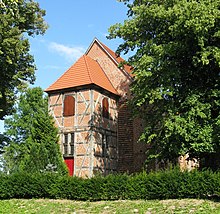Waiting teeth

As Wartezahnung in the will masonry scale teeth for planned extensions called. In the Middle Ages , their execution was one of the basic principles of structural engineering , in which future structures were systematically prepared on the original building .
In the brick and field stone buildings , expected additions were prepared by standing teeth , with bricks protruding from the closing walls. These are tooth-like interlocking cutouts to create a shear-proof connection. The set-back teeth, which are set back in rarer cases and where notches can be seen in the masonry, are called horizontal teeth .
On buildings of all epochs, existing or recognizable as construction seams, former waiting teeth are a particularly important aid for periodization and chronological classification .

literature
- Mila Schrader, Julia Voigt: Building History Lexicon. Building materials, construction methods, architectural details. Suderburg-Hösseringen 2003, ISBN 3-931824-29-2 .
- Mila Schrader: Bricks as historical building material. A material guide and advisor. elsewhere-Verlag, 2015, ISBN 3-931824-02-0 .
Individual evidence
- ↑ Mila Schrader: Interlocking. In: Bauhistorisches Lexikon. 2003, p. 302.
- ↑ Tilo Schöfbeck: Medieval churches between Travelodge and Peene. Berlin 2014, ISBN 978-3-86732-131-0 , pp. 226f.
